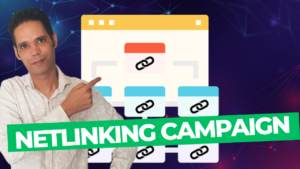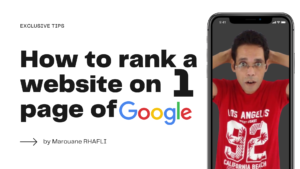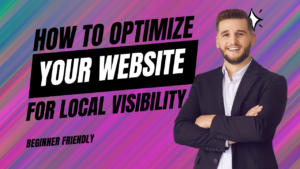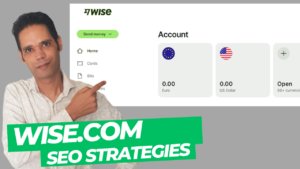
Many individuals seek ways to expand their online presence, and while one of the most popular strategies is to start a blog, many people are unaware of what a blog is and how to create one.
When blogs emerged around 1994, people primarily used them to share their personal lives, including experiences and interests. Today, blogs have evolved into an essential online marketing strategy for businesses and one of the most profitable career choices for individuals.
In this article, you will learn what sets a blog apart from a regular website. We will also cover the most common types of blogs and the necessary elements, such as a web hosting plan, to launch your own blog.
What is a blog?
A blog (shortened form of “weblog”) is an online journal or an information website managed by an individual, a group, or a company, offering regularly updated content (blog post) on a specific subject. It presents information in reverse chronological order and is typically written in an informal or conversational style.
What is the purpose of a blog?
When blogs first emerged on the web, their primary objective was mainly for personal use, such as sharing stories, interests, and thoughts. Let’s explore the most common uses of a blog:
To educate others and build an online presence While the function of a blog remains the same, the type of content has become more diversified. While many blogs still function as online personal diaries, some have started blogging to educate others on a specific subject or to establish a professional online presence.
For instance, David Winer, author of one of the oldest blogs, Scripting News, publishes essays on software development, technological trends, and daily life on his personal web pages.
On the other hand, Natasha Kravchuk shares recipes and tutorials on using specific kitchen tools on her culinary blog, Natasha’s Kitchen. Her blog serves as an essential resource for finding recipes, including for holidays and vegetarian dishes.
As previously mentioned, blogging has also become a lucrative career choice, especially during the pandemic. More than 50% of blogs saw an increase in traffic, and around 35% of bloggers increased their earnings during this period.
Assisting a company in building brand awareness
Many organizations and businesses utilize blogs as part of their content marketing strategies to strengthen their brand’s visibility and increase conversions.
An enterprise blog typically focuses on industry-related information that would interest its target market. Often, the blog is managed by a team of writers rather than a single administrator.
Take a look at Evernote’s corporate blog. It shares tips on productivity, organization, and how its products contribute to optimizing these processes. The brand also uses its blog to share feature updates and company news.
To promote programs and attract visitors
many businesses create blogs in hopes of engaging more visitors and prospects. This is often the case for educational institutions aiming to encourage more students to enroll in their programs.
An excellent example of this practice is the UCLA Bruin Blog. It shares stories from students of diverse backgrounds and majors, showcasing campus life, events, and student organizations. Through this content, visitors to their blog are encouraged to enroll and become part of their program.
What makes a good blog?
If you’re considering creating your own blog, understanding the characteristics of an excellent one is essential. Typically, successful blogs contain the following elements:
- High-quality blog content: Content should demonstrate expertise, authority, and reliability (EAT). It’s also important to use language and formatting that are easy to understand, making the blog post digestible.
- Engaging titles: Titles should reveal the content’s topic and help attract visitors to the content. In fact, around 80% of people will click on search engine results if the titles are compelling. Regularly updated
- content: A consistent publishing schedule lets users know when to visit the blog for fresh content. Search engines prioritize fresh and updated content, which helps improve site ranking and traffic.
Expert Tip: Try to aim for at least three content posts per week and potentially increase to once a day. Also, consider posting in the morning—aligned with your target audience’s time zone—as this fosters email traffic and social sharing.
Active reader engagement refers to any action readers take when visiting a blog, such as reading the entire article, leaving comments, and sharing the article on their social media profiles.
A good User Interface (UI) is essential for a blog, requiring a web design that is aesthetically pleasing for a memorable first impression. This includes layout, typography, and icons. Blog owners should ensure the design is simple, intuitive, and consistent across the entire blog.
A smooth User Experience (UX) is equally important for top blogs, as it significantly impacts blog Search Engine Optimization (SEO). This encompasses mobile-friendliness, HTTPS, and page loading speed.
Take a look at Six-Two’s travel blog. It offers comprehensive travel guides, tips on various destinations, and inspiring travel stories. It maintains a good balance between User Interface (UI) and User Experience (UX) design principles. Six-Two organizes content on a grid while maintaining a simple color scheme, providing an engaging appearance and a clean interface. The blog also loads quickly and is mobile-responsive.
For corporate blogs, a Call-to-Action (CTA) is an additional key element. It guides visitors toward a preferred action after reading articles and helps convert traffic into quality leads.
Take a look at 99designs’ blog. It encourages visitors to use its services by incorporating a CTA button in the header and at the end of each blog article.
Another excellent place to put a CTA is the sidebar, inviting readers to download its free application.
With over 600 million blogs, it’s also crucial to identify and work on what makes you unique to increase your visibility and build a successful blog.
Expert Tip: One of the key strategies to make your blog stand out is to add a personal touch. Share personal stories and experiences, engage with comments, and let people know that you’re there to assist them. Creating these personal touches also helps people recognize that your blog is unique and unlike others.
Aside from sharing personal stories, make your blog unique by experimenting with website design. For instance, Social Media Examiner developed a jungle-themed layout and mascots for their blog, while Dropbox’s blog uses delightful illustrations for its featured images.
7 most common types of blogs
- Personal Blog: Functions like an online diary where the blogger shares personal opinions, often without targeting a specific audience or selling anything. Personal blogs cover various subjects, from family events to professional projects and self-reflection.
- Niche Blog: Provides information on a specific subject, usually related to the blogger’s passions, skills, and knowledge. Examples include blogs focused on books, food, and lifestyle.
- Multimedia Blog: Uses the blog format but publishes multimedia content like videos and podcasts instead of written articles. It typically includes summaries, tables of content, and essential quotes from the video or podcast.
- News Blog: Focuses on the latest events and developments in a specific industry or area. Unlike other blogs, news blogs usually lack personal content or opinions.
- Business or Corporate Blog: Aims to publish relevant content for a company’s industry or update the target market regarding any changes within the company. It can be a section of a company’s website or an independent site.
- Affiliate Blog: Focuses on affiliate marketing—promoting third-party products and services. Affiliate blog owners receive a commission when someone makes a purchase through their custom links. Typical articles include product reviews and referral posts.
- Reverse Blog: Also known as group blogs, several authors create blog posts on related topics, and the blog owner revises and publishes the content.
Some blogs focus on specific categories, while others may combine several types. For instance, Caitlin da Silva’s personal blog contains articles with affiliate links and multimedia content.
What is the difference between a blog and a website?
The primary difference between a blog and a website lies in how content is presented and updated:
Blogs: Blogs are dynamic platforms that regularly publish new content, usually organized by date, with the most recent articles at the top of the page. They are often used to share opinions, personal reflections, news, and frequent updates on specific subjects.
Traditional Websites: Conventional websites tend to offer static information and are designed to present data, products, or services more permanently. They generally provide a fixed structure with separate sections for information presentation but may not be updated frequently.
Regarding Reedsy, it’s primarily a static website, but it also includes a blog section that provides updates, advice, or recent information, adding a dynamic dimension to their online presence.
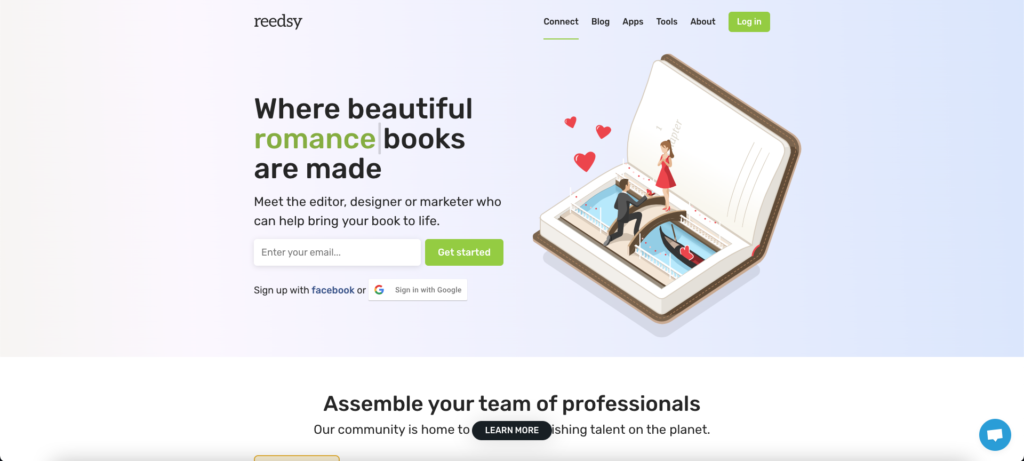
The main content comprises web pages informing visitors about the company’s writing and editing services, which have remained unchanged for a long time.
In the blog section, new articles are added every few days to inform readers about book writing and publishing. The blog automatically provides more frequent updates compared to other sections, such as the About and Apps pages.
Blog articles typically include a comments section where readers and the author engage with each other. It’s an excellent way to gather feedback and maintain a personal relationship with visitors.
However, a comments section is not commonly found on a standard web page as it usually doesn’t encourage public engagement.
Blogs also often integrate an RSS (Really Simple Syndication) feed, a link that sends content to a web browser or a feed-reading app like Google Reader.
Visitors can subscribe to your blog’s RSS feed and receive updates whenever you publish a new article. Digital marketers often link their blog’s RSS feed to web push notifications or email newsletters to inform subscribers about the latest articles and product announcements.
Many blogs are also self-contained – they function as an entire website and display articles directly on the homepage, such as Ann Althouse’s blog, Althouse.
What is the difference between a blog and a wiki?
A blog is typically created and owned by an individual or an organization to share information and may have one or multiple authors.
In contrast, a wiki is a collaborative website where many people can add, edit, and publish content.
The timelines of blog articles and comments are usually significant in indicating the most recent updates.
Conversely, the publication date of an article in a wiki is less important as it is continuously updated when new information becomes available.
Compared to blog articles, which often highlight credits, creating and editing content in a wiki is most often anonymous. Here, the focus is on information rather than necessarily on the contributors.
Wikipedia is one of the most famous examples of a wiki. The site is written and maintained by volunteers worldwide. Content editing is open to everyone, but creating new pages and uploading images requires creating an account.
Why do you need your own blog?
For personal use, a blog serves as an excellent way to express thoughts and opinions, while businesses can create a blog to educate their target audience.
Moreover, nowadays, anyone can create a blog. Unlike the early days of blogging that required coding skills to update an article, people can now use blogging software such as WordPress, Blogger, and website builder. These platforms allow individuals to create a blog within minutes without worrying about technical complexities.
However, to become successful bloggers, owners must identify the reasons and goals for maintaining their blog.
Here are six reasons to start blogging:
- Share knowledge: Many individuals maintain a blog to share their experiences without relying on journalists or media companies. When people have their own blog, they can control the style, language, and information.
- Build a personal brand: A blog is an excellent platform to demonstrate skills and knowledge, which helps make a strong impression on employers and stand out. In fact, many professionals have successfully landed jobs through their blogs.
- Earn money: Earning money through blogging is possible for most blogs, especially those with a substantial reader base. Blog owners can create sponsored posts, display advertisements, or sell their own products and services.
- Enhance online visibility of a website: Websites with a blog have 434% more indexed pages in search engines, increasing the chances of better search rankings. Additionally, it will make it easier for internet users to find your content when searching for your name or brand online.
- Acquire new customers: After reaching higher ranks, a blog with relevant content can eventually bring more traffic and prospects, as 81% of buyers conduct online research before making a purchase.
- Create an online community: Blogs provide a platform where visitors can comment and interact with the authors.
How are bloggers paid?
Bloggers’ income depends on their traffic and monetization methods. Generally, blogs with hundreds of thousands of page views find it easier to generate revenue by selling products or displaying paid advertisements (PPC).
Bloggers can also encourage their readers to purchase products using their affiliate links and collaborate with brands for sponsored posts.
For instance, Jeremy’s travel blog, Living the Dream, earned $4,825 in January 2022. On the other hand, Adam Enfroy generated around $67,000 per month in 2020, an outstanding amount for a blogging business.
Those looking to start a blog and earn money should first focus on building their audience to generate stable income. Check out our video tutorial on how to start making money with a blog.
Further read: Earn money on the Internet: 30 ideas to make money
Choosing a profitable niche is crucial if you’re looking to pursue blogging as a career. Lucrative niches offer better opportunities, such as high-paying affiliate offers and advertisements from paid advertising networks.
Opting for a niche solely based on passion might not always translate to consistent profits. For instance, travel bloggers could experience declines in traffic and revenue due to travel restrictions.
Some of the most profitable niches include:
- Insurance: This is the highest paying niche with an average CPC of $17.55 in several countries like the United States, Australia, and Canada. Popular keywords in this niche include life insurance, auto insurance, and health insurance.
- Online education: The flexibility and convenience of online education drive its popularity. The online education market is estimated to surpass $243 billion in 2022.
- Digital marketing and advertising: The digital marketing sector has experienced remarkable growth during the pandemic. It’s a highly demanded subject, allowing bloggers to create content on social media marketing and brand management.
- Personal finance: Money-related topics remain evergreen in blogging. Besides writing blog articles on money management and investments, bloggers can sell online courses, e-books, and financial advisory services.
- Lifestyle and wellness: Lifestyle blog categories encompass personal care, wellness, and fitness.
Expert Tip: Start by focusing on a niche subject and gradually expand to broader topics over time. When dealing with a niche topic, you build a brand, establishing authority in that specific area. Once you’ve gained enough authority, you can transition to broader subjects.
Once you’re ready to monetize your blog, ensure to include contact information such as an email address and social media profiles on the Contact page of your blog. This helps potential clients reach out to you easily.
What do you need to start a blog?
Now that we’ve covered the basic concept of blogging – from what a blog is to its benefits and types, it’s time to delve into the essential elements for creating your first blog.
Here are six elements to prepare before launching a blog:
- Domain name: This is your blog’s address, like yourblog.com. Ideally, the domain name should represent your business name or the general theme of the blog. Check if the name is available using our domain name search tool. If you’re still unsure about the name for your blog, use blog name generators to explore different possibilities.
- Web hosting service: You’ll need hosting to store all the blog’s files, including images and code files, and make them available to users. Generally, WordPress hosting is an excellent solution for a small personal or lifestyle blog, while cloud web hosting is ideal for high-traffic blogs.
- Blogging platform: You can create your blog using a content management system (CMS) like WordPress or a website builder like Hostinger’s. Users creating a WordPress site typically seek complete control and extensive customization, while users of the website builder prefer its quick setup and user-friendly interface for beginners.
Skills in content writing: Writing a blog post is different from an academic essay or a book. Consider enrolling in a free online course like SurferSEO’s SEO Writing Masterclass to enhance your content writing and SEO skills.
- Theme or template: This refers to a pre-made web design for your blog. Most CMS platforms and website builders provide free templates, but you can purchase a customized blog theme from a third-party marketplace like ThemeForest or even design one yourself.
- Blogging tools: Several tools can aid in producing better blog articles and managing your blog. For instance, use Trello to create an editorial calendar and Yoast SEO to optimize content for search engines.
Another essential element to start a blog is confidence. Many beginners feel they are not experts in the field, which holds them back from sharing content. To overcome this, begin by sharing your personal experiences and use storytelling to engage your audience.
Expert Tip: Suppose you’re starting in a field where you’re not an expert. Here, you can talk about your journey, including your feelings, likes, and dislikes.
People can follow you through your journey, and as they do, there’s an emotional connection. Moreover, you learn and improve, eventually leading you to an expert position.
Conclusion
Creating a blog offers numerous advantages. It can assist individuals in building a personal brand and generating extra income or even a full-time revenue stream.
If you’re considering blogging for online income, consider selecting a profitable niche to maximize opportunities for higher-paying sponsored posts or affiliate offerings.
Business owners also establish blogs to improve their website’s search engine ranking, attract customers, and cultivate a loyal online community.
Regardless of your goal, successful blogs go beyond mere content publication. It’s crucial to prioritize quality, consistency, and the overall design of the site.
If you’re venturing into your first blog, ensure you acquire a fitting domain name and the best hosting plan for your needs. Next, select a blogging platform and enhance your content writing skills by enrolling in online courses.

